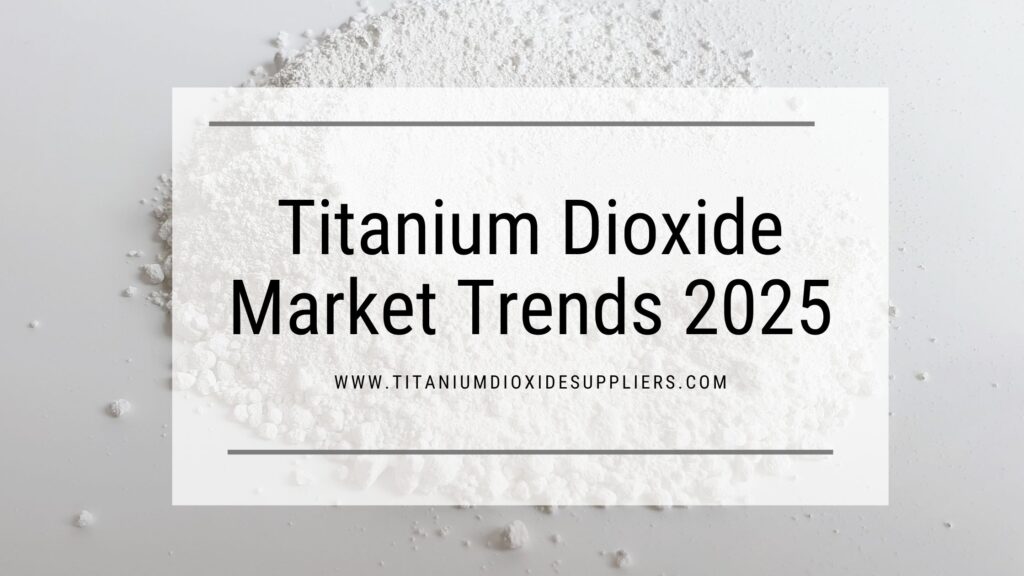Titanium Dioxide (TiO₂) has become a vital component in modern industry, used extensively in paints, plastics, cosmetics, paper, textiles, and even food. As of 2025, the market is not only expanding but also transforming under the influence of technological innovation, sustainability goals, and shifting global supply chains.
Let’s explore the current trends driving this growth and what lies ahead for suppliers, manufacturers, and end users of Titanium Dioxide.
Global Market Outlook
The Titanium Dioxide market is expected to grow steadily in 2025, with a compound annual growth rate (CAGR) of about 5%–6 %. This expansion is largely due to increased demand from the construction, packaging, automotive, and personal care industries. Asia-Pacific leads the global consumption, with China and India emerging as key production and consumption centers.
Key Trends Fueling Demand in 2025
1. Surge in Construction and Infrastructure
Post-pandemic infrastructure projects and real estate development are accelerating across countries like India, Brazil, Vietnam, and South Africa. Titanium Dioxide is a key ingredient in white paints, primers, concrete coatings, and sealants, making it indispensable in the construction sector.
2. Growing Automotive Production
As the automotive sector rebounds from global supply chain disruptions, TiO₂ is seeing renewed demand in vehicle paints and protective coatings. Its properties—UV resistance, opacity, and durability—make it ideal for automotive finishes.
3. Expanding Plastics and Packaging Market
Plastics infused with TiO₂ are used in packaging materials, especially for food and pharmaceuticals, because of their whiteness and ability to block UV radiation. With e-commerce booming and eco-packaging gaining popularity, the demand for high-performance plastics is pushing up TiO₂ consumption.
4. Natural and Clean Cosmetics
Mineral-based skincare and sunscreens are increasingly favored by conscious consumers. Titanium Dioxide, known for being a safe and effective physical sunblock, is now a popular ingredient in face powders, foundations, and sun-protection creams. Brands are highlighting it as non-toxic, non-comedogenic, and reef-safe.
5. Shift Toward Chloride Process
The traditional sulfate process is being phased out in favor of the more sustainable chloride process, which produces higher-purity TiO₂ with less waste and lower energy consumption. Manufacturers investing in this technology are setting new quality and environmental standards.
6. Push for Sustainability
Environmental concerns are driving efforts to make Titanium Dioxide production more eco-friendly. This includes reducing carbon emissions, recycling titanium waste, and developing bio-based dispersions and water-based coatings that utilize TiO₂ more efficiently.
7. Stringent Regulatory Frameworks
Regulatory bodies like the European Chemicals Agency (ECHA) and the US FDA have imposed strict labeling and handling guidelines for Titanium Dioxide, especially in powder form or in nanoparticle applications. However, such regulations are also encouraging innovation in formulation, making TiO₂ safer and more versatile.
8. Technological Breakthroughs
Advanced research has led to new uses of Titanium Dioxide in self-cleaning surfaces, solar cells, and air purification. Nano-TiO₂ is now being used in coatings that break down pollutants and bacteria under sunlight, showing how the market is expanding beyond traditional industries.
9. China’s Dominance and India’s Rise
While China remains the dominant supplier globally, Indian manufacturers are quickly scaling up production, offering competitive pricing, and improving quality to cater to both domestic and international markets.
Applications Across Industries
Titanium Dioxide finds wide application across:
- Paints & Coatings: Enhances brightness, opacity, and weather resistance.
- Plastics: Adds whiteness and UV resistance in packaging, consumer goods, and industrial parts.
- Cosmetics: Acts as a safe mineral sunscreen and pigment.
- Paper: Improves brightness and opacity in specialty paper products.
- Food Industry: Used in food coloring and as a whitening agent in confectionery and chewing gum.
Its versatility is one of the reasons the demand continues to grow across sectors and geographies.
Challenges Ahead
Despite its popularity, the Titanium Dioxide market is not without hurdles. The major challenges include:
- Volatile raw material prices, such as ilmenite and rutile.
- Energy-intensive manufacturing processes, especially in sulfate-based plants.
- Regulatory pushbacks regarding nano-TiO₂ and potential inhalation risks.
- Environmental concerns over waste disposal and carbon footprint.
- Global supply chain instability due to geopolitical conflicts or trade restrictions.
These challenges are forcing manufacturers to innovate and comply with stricter global standards while maintaining affordability.
What to Expect in the Future?
Looking forward, Titanium Dioxide is poised to play a key role in the transition toward green manufacturing, sustainable packaging, and energy-efficient products. Expect to see:
- Growth in eco-label compliant TiO₂ coatings
- Increasing use in energy devices like solar panels and photocatalysts
- High demand for nano-TiO₂ in smart city infrastructure
- Greater investments in India and Southeast Asia’s TiO₂ manufacturing capacity
Innovation and sustainability will be the twin drivers of market leadership in the years ahead.
Conclusion
Titanium Dioxide is more than just a pigment—it’s a powerful industrial material at the heart of innovation, sustainability, and economic growth. As we head deeper into 2025, its demand will be shaped by green chemistry, urbanization, and cleaner formulations.
Whether you’re a manufacturer, supplier, or end-user, understanding these evolving trends is critical. The future of Titanium Dioxide isn’t just white—it’s bright, green, and global.
FAQs
Q1. Is Titanium Dioxide safe for human use?
Yes. Titanium Dioxide is generally regarded as safe when used according to regulatory guidelines. It is commonly used in food, cosmetics, and pharmaceuticals, though inhalation of fine powders is discouraged.
Q2. What’s the difference between rutile and anatase Titanium Dioxide?
Rutile is more stable and has better UV resistance, making it suitable for outdoor applications. Anatase has higher photocatalytic activity and is often used in applications like self-cleaning surfaces.
Q3. Why is TiO₂ used in sunscreens?
Titanium Dioxide reflects and scatters harmful UV rays, making it an effective, non-chemical sunblock for sensitive skin.
Q4. Which countries are leading in Titanium Dioxide production?
China is the largest producer, followed by the USA, Germany, and increasing production from India and South Korea.
Q5. Is there a substitute for Titanium Dioxide?
While alternatives like zinc oxide exist, none match the opacity, brightness, and UV resistance TiO₂ offers across such a wide range of applications.





